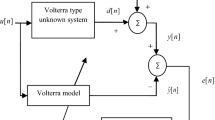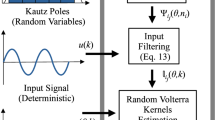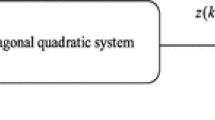Abstract
In this paper, we address the problem of structure identification of Volterra models. It consists in estimating the model order and the memory length of each kernel. Two methods based on input-output crosscumulants are developed. The first one uses zero mean independent and identically distributed Gaussian input, and the second one concerns a symmetric input sequence. Simulations are performed on six models having different orders and kernel memory lengths to demonstrate the advantages of the proposed methods.
Similar content being viewed by others
Explore related subjects
Discover the latest articles and news from researchers in related subjects, suggested using machine learning.References
V. J. Mathews, G. L. Sicuranza. Polynomial Signal Processing, Wiley InterScience, 2000.
T. Ogunfunmi. Adaptive Nonlinear System Identification: The Volterra and Wiener Model Approaches, Springer, 2007.
O. M. Mohamed Vall, R. M’hiri. An Approach to Polynomial NARX/NARMAX Systems Identification in a Closed-loop with Variable Structure Control. International Journal of Automation and Computing, vol. 5, no. 3, pp. 313–318, 2005.
S. A. Billings. Identification of Nonlinear Systems — A Survey. IEE Proceedings Part D: Control Theory and Applications, vol. 127, no. 6, pp. 272–285, 1980.
O. Nelles. Nonlinear System Identification, Springer, Berlin Heidelberg, Germany, 2001.
M. Schetzen. The Volterra and Wiener Theories of Nonlinear Systems, John Wiley and Sons Inc., New York, USA, 1980.
Y. Li, H. Kashiwagi. High-order Volterra Model Predictive Control and Its Application to a Nonlinear Polymerisation Process. International Journal of Automation and Computing, vol. 2, no. 2, pp. 208–214, 2005.
P. Koukoulas, N. Kalouptsidis. Nonlinear System Identification Using Gaussian Inputs. IEEE Transactions on Signal Processing, vol. 43, no. 8, pp. 1831–1841, 1995.
P. Koukoulas, N. Kalouptsidis. Third order Volterra System Identification. In Proceedings of IEEE International Conference on Acoustics, Speech, and Signal Processing, IEEE Computer Society, vol. 3, pp. 2405–2408, 1997.
P. Koukoulas, N. Kalouptsidis. Second-order Volterra System Identification. IEEE Transactions on Signal Processing, vol. 48, no. 12, pp. 3574–3577, 2000.
P. Koukoulas, N. Kalouptsidis. Blind Identification of Second Order Hammerstein Series. Signal Processing, vol. 83, no. 1, pp. 213–234, 2003.
N. Kalouptsidis, P. Koukoulas. Blind Identification of Volterra — Hammerstein Systems. IEEE Transactions on Signal Processing, vol. 53, no. 8, pp. 2777–2787, 2005.
P. Koukoulas, V. Tsoulkas, N. Kalouptsidis. A Cumulant Based Algorithm for the Identification of Input-output Quadratic Systems. Automatica, vol. 38, no. 3, pp. 391–407, 2002.
E. J. Powers, C. P. Ritz, C.K. An, S.B. Kim, R.W. Miksad, S. W. Nam. Applications of Digital Polyspectral Analysis to Nonlinear Systems Modelling and Nonlinear Wave Phenomena. In Proceedings of Workshop on Higher-order Spectral Analysis, IEEE Press, Vail, Colorado, USA, pp. 73–77, 1989.
J. M. Le Caillec, R. Garello. Time Series Nonlinearity Modelling: A Giannakis Formula Type Approach. Signal Processing, vol. 83, no. 8, pp. 1759–1788, 2003.
G. H. Golub, C. F. Van Loan. Matrix Computations, The Johns Hopkins University Press, USA, 1996.
C. L. Nikias, A. P. Petropulu. Higher-order Spectra Analysis: A Nonlinear Signal Processing Framework, Prentice-Hall, Englewood Cliffs, New Jersey, USA, 1993.
J. L. Lacoume, P. O. Amblard, P. Comon. Statistiques d’ordre suprieur pour le traitement du signal, Masson, Paris, France, 1997. (in French)
J. M. Mendel. Tutorial on Higher Order Statistics (Spectra) in Signal Processing and System Theory: Theorical Results and Some Applications. Proceedings of the IEEE, vol. 79, no. 3, pp. 278–305, 1991.
C. L. Nikias, J. M. Mendel. Signal Processing with Higher-order Spectra. IEEE Signal Processing Magazine, vol. 10, no. 3, pp. 10–37, 1993.
G. Favier, Estimation paramètrique de modèles entresortie. In Signaux aléatoires: modélisation, estimation, détection, Traité IC2, chapitre 7, M. Gugliemi (ed.), Lavoisier, Hermes Science Publications, Paris, France, 2004. (in French)
Author information
Authors and Affiliations
Corresponding author
Additional information
Houda Mathlouthi received the engineering diploma in electrical engineering from the Ecole Nationale d’Ingenieurs de Gabes (ENIG), Tunisia in 2002, and the master degree in automatic control from the Ecole Nationale d’Ingenieurs de Sfax (ENIS), Tunisia. She is a member of Laboratory of Numerical Control of Industrial Processes (LACONPRI) at the ENIG from 2003. Currently, she is a Ph.D. candidate at the ENIS, and is an assistant at the ENIG.
Her research interests include linear and nonlinear process modeling and identification using higher-order statistics.
Kamel Abederrahim received the engineering diploma in electrical engineering from the Ecole Nationale d’Ingenieurs de Gabes (ENIG), Tunisia in 1992, and the master degree in automatic control from the Ecole Superieure des Sciences et Techniques de Tunis (ESSTT), Tunisia in 1995 and the Doctorate degree in electrical engineering from the Ecole Nationale d’Ingenieurs de Tunis (ENIT), Tunisia in 2000. He is a member of Laboratory of Numerical Control of Industrial Processes (LACONPRI) at the ENIG from 1995. He joined the ENIG as an assistant professor in 2000. From 2002 to 2005, he was the director of the Electrical Engineering Department at the ENIG, and now he is the director of the Institut Superieur des Systemes Industriels de Gabes (ISSIG), Tunisia.
His research interests include nonlinear process modeling, identification, and control.
Faouzi Msahli received the M. Sc. in electrical engineering from the Ecole Normale Suprieure de l’Enseignement Technique de Tunis (ENSET), Tunisia in 1987, and the Doctorate degree in electrical engineering from the Ecole Nationale d’Ingenieurs de Tunis (ENIT), Tunisia in 1996, and the Habilitation in electrical engineering from the Ecole Nationale d’Ingenieurs de Sfax (ENIS), Tunisia in 2002. He is a member of Laboratory of Numerical Control of Industrial Processes (LACONPRI) at the ENIG from 1988. He joined the ENIG as an assistant professor from 1989 to 1999, and now he works as a professor and an assistant director at the Ecole Nationale d’Ingenieurs de Monastir (ENIM), Tunisia.
His present research interests include nonlinear process modeling and identification, and predictive control.
Gerard Favier received the engineering diplomas from École Nationale Suprieure de Chronomtrie et de Micromcanique (ENSCM), Besanon, France and École Nationale Suprieure de l’Aronautique et de l’Espace (ENSAE), Toulouse, France and the engineering doctorate and state doctorate degrees from the University of Nice Sophia Antipolis, France in 1973, 1974, 1977, and 1981, respectively. In 1976, he joined the Centre National de la Recherche Scientifique (CNRS), France and now he works as a research director of CNRS at the I3S Laboratory, Sophia Antipolis. From 1995 to 1999, he was the director of the I3S Laboratory.
His research interests include nonlinear process modeling and identification, tensor modeling of wireless communication systems, nonlinear and blind equalization, and predictive control.
Rights and permissions
About this article
Cite this article
Mathlouthi, H., Abederrahim, K., Msahli, F. et al. Crosscumulants based approaches for the structure identification of Volterra models. Int. J. Autom. Comput. 6, 420–430 (2009). https://doi.org/10.1007/s11633-009-0420-0
Received:
Revised:
Published:
Issue Date:
DOI: https://doi.org/10.1007/s11633-009-0420-0




